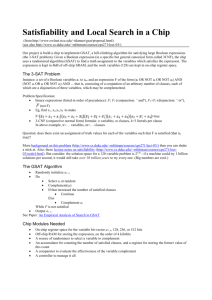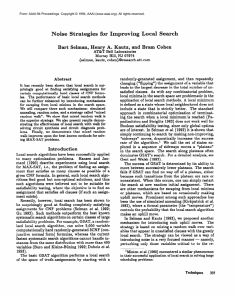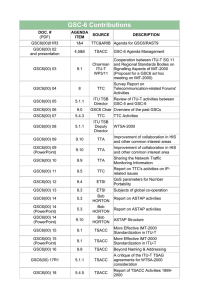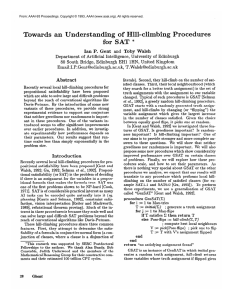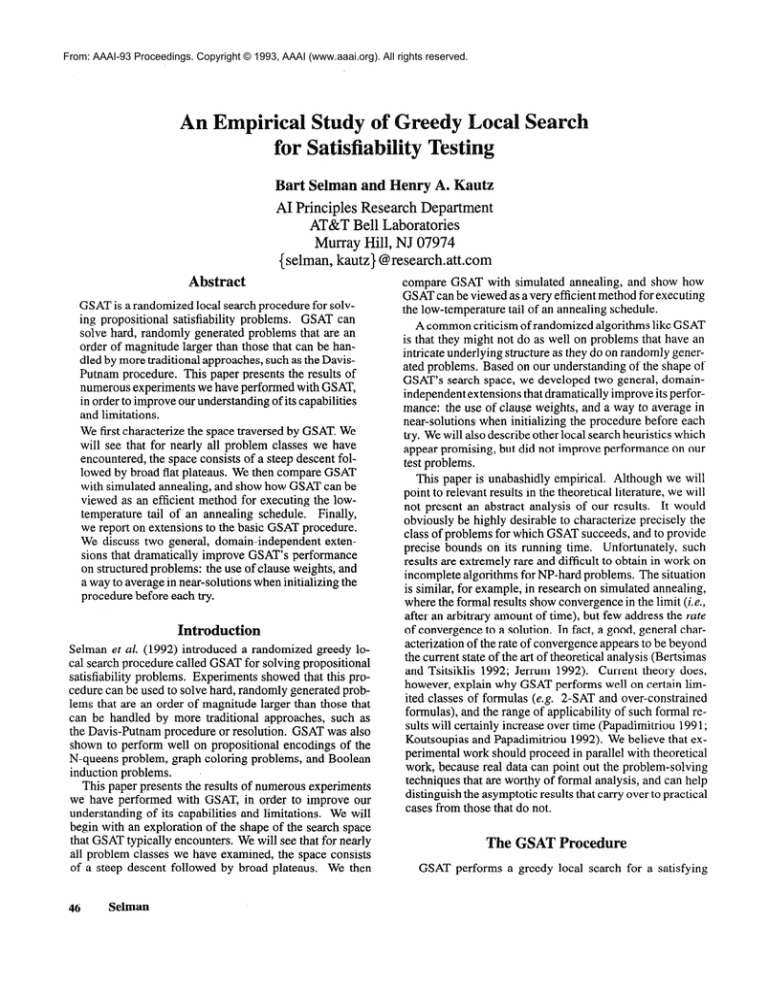
From: AAAI-93 Proceedings. Copyright © 1993, AAAI (www.aaai.org). All rights reserved.
An Empir
art Sehnan and
AI Principles Research Department
AT&T Bell Laboratories
Murray Hill, NJ 07974
{ selman, kautz} @research.att.com
Abstract
GSAT is a randomized local search procedure for solving propositional satisfiability problems.
GSAT can
solve hard, randomly generated problems that are an
order of magnitude larger than those that can be handled by more traditional approaches, such as the DavisPutnam procedure. This paper presents the results of
numerous experiments we have performed with GSAT,
in order to improve our understanding of its capabilities
and limitations.
We first characterize the space traversed by GSAT. We
will see that for nearly all problem classes we have
encountered, the space consists of a steep descent followed by broad flat plateaus. We then compare GSAT
with simulated annealing, and show how GSAT can be
viewed as an efficient method for executing the lowtemperature tail of an annealing schedule.
Finally,
we report on extensions to the basic GSAT procedure.
We discuss two general, domain-independent
extensions that dramatically improve GSAT’s performance
on structured problems: the use of clause weights, and
a way to average in near-solutions when initializing the
procedure before each try.
Introduction
Selman et al. (1992) introduced a randomized greedy local search procedure called GSAT for solving propositional
satisfiability problems. Experiments showed that this procedure can be used to solve hard, randomly generated problems that are an order of magnitude larger than those that
can be handled by more traditional approaches, such as
the Davis-Putnam procedure or resolution. GSAT was also
shown to perform well on propositional encodings of the
N-queens problem, graph coloring problems, and Boolean
induction problems.
This paper presents the results of numerous experiments
we have performed with GSAT, in order to improve our
understanding of its capabilities and limitations.
We will
begin with an exploration of the shape of the search space
that GSAT typically encounters. We will see that for nearly
all problem classes we have examined, the space consists
of a steep descent followed by broad plateaus.
We then
46
Selman
compare GSAT with simulated annealing, and show how
GSAT can be viewed as a very efficient method for executing
the low-temperature tail of an annealing schedule.
A common criticism of randomized algorithms like GSAT
is that they might not do as well on problems that have an
intricate underlying structure as they do on randomly generated problems. Based on our understanding of the shape of
GSAT’s search space, we developed two general, domainindependent extensions that dramatically improve its performance: the use of clause weights, and a way to average in
near-solutions when initializing the procedure before each
try. We will also describe other local search heuristics which
appear promising, but did not improve performance on our
test problems.
This paper is unabashidly empirical. Although we will
point to relevant results in the theoretical literature, we will
not present an abstract analysis of our results. It would
obviously be highly desirable to characterize precisely the
class of problems for which GSAT succeeds, and to provide
precise bounds on its running time. Unfortunately,
such
results are extremely rare and difficult to obtain in work on
incomplete algorithms for NP-hard problems. The situation
is similar, for example, in research on simulated annealing,
where the formal results show convergence in the limit (i.e.,
after an arbitrary amount of time), but few address the rate
of convergence to a solution. In fact, a good, general characterization of the rate of convergence appears to be beyond
the current state of the art of theoretical analysis (Bertsimas
and Tsitsiklis 1992; Jerrum 1992). Current theory does,
however, explain why GSAT performs well on certain limited classes of formulas (e.g. 2-SAT and over-constrained
formulas), and the range of applicability of such formal results will certainly increase over time (Papadimitriou 199 1;
Koutsoupias and Papadimitriou 1992). We believe that experimental work should proceed in parallel with theoretical
work, because real data can point out the problem-solving
techniques that are worthy of formal analysis, and can help
distinguish the asymptotic results that carry over to practical
cases from those that do not.
The GSAT Procedure
GSAT performs
a greedy local search for a satisfying
Procedure GSAT
Input: a set of clauses a, MAX-FLIPS, and MAX-TRIES
Output: a satisfying truth assignment of Q, if found
for i := 1 to MAX-TRIES
T := a randomly generated truth assignment
for j := 1 to MAX-FLIPS
if T satisfies a then return T
P := a propositional variable such that a change
in its truth assignment gives the largest
increase in the total number of clauses
of a that are satisfied by T
T := T with the truth assignment of p reversed
end for
end for
return “no satisfying assignment found”
Figure 1: The GSAT procedure.
assignment of a set of propositional clauses.* The procedure
starts with a randomly generated truth assignment. It then
changes (‘flips’) the assignment of the variable that leads to
the largest increase in the total number of satisfied clauses.
Such flips are repeated until either a satisfying assignment
is found or a pre-set maximum number of flips (MAXFLIPS) is reached. This process is repeated as needed up
to a maximum of MAX-TRIES times. See Figure 1. (For a
related approach, see Gu (1992))
GSAT mimics the standard local search procedures used
for finding approximate solutions to optimization problems
(Papadimitriou and Steiglitz 1982) in that it only explores
potential solutions that are “close” to the one currently being
considered. Specifically, we explore the set of assignments
that differ from the current one on only one variable. The
GSAT procedure requires the setting of two parameters,
MAX-FLIPS and MAX-TRIES, which determine, respectively, how many flips the procedure will attempt before
giving up and restarting, and how many times this search
can be restarted before quitting. As a rough guideline, setting MAX-FLIPS equal to about ten times the number of
variables is sufficient. The setting of MAX-TRIES will generally be determined by the total amount of time that one
wants to spend looking for an assignment before giving up.
In our experience so far, there is generally a good setting of the parameters that can be used for all instances of
an application.
Thus, one can fine-tune the procedure by
experimenting with various parameter settings.
It is important to understand that we are not suggesting that the
parameters need to be reset for each individual problem only for a broad class, for example, coloring problems, random formulas, etc. Practically all optimization algorithms
for intractable problems have parameters that must be set
this way,2 so this is not a particular disadvantage of GSAT.
Furthermore, one could devise various schemes to auto‘A clause is a disjunction of literals. A literal is a propositional
variable or its negation. A set of clauses corresponds to a formula
in conjunctive normal form (CNF): a conjunction of disjunctions.
Thus, GSAT handles CNF-SAT.
2For example, see the discussion on integer programming methods in Fourer (1993).
matically choose a good parameter setting by performing a
binary search on different parameter settings on a sequence
of problems.
Summary of Previous
In Selman et al. (1992), we showed that GSAT substantially
outperforms backtracking search procedures, such as the
Davis-Putnam procedure, on various classes of formulas.
For example, we studied GSAT’s performance on hard randomly generated formulas. (Note that generating hard random formulas for testing purposes is a challenging problem
by itself, see Cheeseman etal. (1991); Mitchell etal. (1992);
William and Hogg (1992); Larrabee and Tsuji (1993); and
Crawford and Auton (1993).) The fastest backtrack type
procedures, using special heuristics, can handle up to 350
variable hard random formulas in about one hour on a MIPS
workstation (Buro and Kleine Burring 1992; Crawford and
Auton 1993). Nevertheless, the running time clearly scales
exponentially, for example, hard 450 variable formulas are
undoable. Our current implementation of GSAT, using the
random walk option discussed in Selman and Kautz (1993),
solves hard 1500 variable formulas in under an hour. Selman et al. also showed that GSAT performs well on propositional encodings of the N-queens problem, hard instances of
graph coloring problems (Johnson et al. 199 l), and Boolean
induction problems (Kamath et al. 1992).
e Sears
ace
Crucial to a better understanding of GSAT’s behavior is the
manner in which GSAT converges on an assignment.
In
Figure 2, we show how the GSAT’s search progresses on a
randomly generated 100 variable problem with 430 clauses.
Along the horizontal axis we give the number of flips, and
along the vertical axis the number of clauses that still remained unsatisfied. (The final flip reduces this number to
zero.) It is clear from the figure that most of the time is spent
wandering on large plateaus. Only approximately the first
5% of the search is spent in pure greedy descent. We have
observed qualitatively similar patterns over and over again.
(See also the discussion on “sideway” moves in Selman et
al. (1992), and Gent and Walsh (1993).)
The bottom panel in Figure 2 shows the search space
for a 500 variable, 2 150 clause random satisfiable formula.
The long tableaus become even more pronounced, and the
relative size of the pure greedy descent further diminishes.
In general, the harder the formulas, the longer the tableaus.
Another interesting property of the graphs is that we see
no upwards moves. An upward move would occur when
the best possible flip increases the number of unsatisfied
clauses. This appears to be extremely rare, especially for
the randomly generated instances.
The search pattern brings out an interesting difference
between our use of GSAT and the standard use of local
search techniques for obtaining good approximate solutions
to combinatorial optimization problems (Lin and Kernighan
1973; Papadimitriou and Steiglitz 1982; Papadimitriou et
al. 1990). In the latter, one generally halts the local search
procedure as soon as no more improvement is found. Our
AutomatedReasoning
47
60
50
40
#
unsat
30
20
10
0
0
50
100
150
4
6
200
250
# flips
300
350
400
450
500
14
16
18
20
250
200
#
unsat
150
0
0
2
?
# flks
(inl~housla2nds)
Figure 2: GSAT’s search space on a 00 and 500 variables formulas.
figure shows that this is appropriate when looking for a
near-solution, since most of the gain lies in the early, greedy
descent part. On the other hand, when searching for a global
minimum (i.e., a satisfying assignment) stopping when flips
do not yield an immediate improvement is a poor strategy most of the work occurs in satisfying the last few remaining
clauses.
Note that finding an assignment that satisfies all clauses of
a logical theory is essential in many reasoning and problem
solving situations. For example, in our work on planning as
satisfiability, a satisfying assignment correspond to a correct
plan (Kautz and Selman 1992). The near-satisfying assignments are of little use; they correspond to plans that contain
one of more “magical” moves, where blocks suddenly shift
positions.
48
Sehan
Simulated Annealing
Simulated annealing is a stochastic local search method. It
was introduced by Kirkpatrick et al. (1983) to tackle combinatorial optimization problems. Instead of pure greedy local search, the procedure allows a certain amount of “noise”
which enables it to make modifications that actually increase the cost of the current solution (even when this is not
the best possible current modification). In terms of finding
satisfying assignments, this means that the procedure sometimes allows flips that actually increase the total number of
unsatisfied clauses. The idea is that by allowing random occurrences of such upwards moves, the algorithm can escape
local minima. The frequency of such moves is determined
by a parameter T, called the temperature. (The higher the
temperature, the more often upward moves occur.)
The parameter T is set by the user. Normally, one follows a so-called annealing schedule in which one slowly
decreases the temperature until T reaches zero. It can be
shown formally that provided one “cools” slowly enough,
the system will find a global minimum.
Unfortunately,
the analysis uses an exponentially long annealing schedule,
making it only of theoretical interest (Hajek 1988). Our real
interest is in the rate of convergence to a global minimum for
more practical annealing schedules. Current formal methods, however, appear too weak to tackle this question.3
It is interesting to compare the plot for GSAT (Figure 2)
with that for annealing (Figure 3) on the same 100 variable
random formula.4 In the early part of the search, GSAT
performs pure greedy descent. The descent is similar to
the initial phase of an annealing schedule, although more
rapid, because GSAT performs no upward moves. In the
next stage, both algorithms must search along a series of
long plateaus. GSAT makes mostly sideways moves, but
takes advantage of a downward move whenever one arises.
Annealing has reached the long, low-temperature “tail” of
its schedule, where it is very unlikely to make an upward
move, but allows both sideways and downward moves. Because much of the effort expended by annealing in the initial
high temperature part of the schedule is wasted, it typically
takes longer to reach a solution. Note, for example, that
after less than 500 moves GSAT has reached a satisfying
assignment, while the annealing algorithm still has 5 unsatisfied clauses. A more rapid cooling schedule would, of
course, more closely mimick GSAT.
Thus we can view GSAT as a very efficient method for
executing the low-temperature tail of an annealing schedule. Furthermore, our experiments with several annealing
schedules on hard, random formulas confirmed that most
of the work in finding a true satisfying assignment is in the
tail of the schedule. In fact, we were unable to find an annealing schedule that performed better than GSAT, although
we cannot rule out the possiblity that such a schedule exists. This is an inherent difficulty in the study of annealing
approaches (Johnson et al. 1991).
xtensions
The basic GSAT algorithm is quite elementary, and one
might expect that more sophisticated algorithms could yield
better performance.
We investigated several extensions to
GSAT, and found a few that were indeed successful. But it
is important to stress that the basic GSAT algorithm is very
robust, in the sense that many intuitively appealing modifications do not in fact change its performance.
We have
found that experimental study can help reveal the assumptions, true or false, implicit in such intuitions, and can lead
3Recent work by Pinkas and Dechter (1992) and Jerrum (1992)
provides some interesting formal convergence results for a special
class of optimization problems.
4We use the annealing algorithm given in Johnson et al. (1991).
Start with a randomly generate truth assignment; repeatedly pick
a random variable, and compute how many more clauses become
satisfied when the truth value of that variable is flipped - call this
number 6. If 6 2 0, make the flip. Otherwise, flip the variable
with probability e ‘IT . We slowly decrease the temperature from
10 down to 0.05.
to interesting
research.
Improving t
questions
for further empirical
or theoretical
nitid Assignment
One natural intuition about GSAT is that it would be better to
start with an initial assignment that is “close” to a solution,
rather than with a totally random truth assignment. Indeed,
the theoretical analysis of general greedy local search presented in (Minton et al. 1992) shows that the closer the
initial assignment is to a solution, the more likely it is that
local search will succeed.
Therefore we tried the following method for creating better initial assignments: First, a variable is assigned a random
value. Next, all clauses containing that variable are examined, to see if the values of any unassigned variables are
then determined by unit propagation. If so, these variables
are assigned, and again unit propagation is performed. (If a
clause is unsatisfied by the current partial assignment, it is
simply ignored for the time being.) When no more propagations are possible, another unassigned variable is given a
random value, and the process repeats.
Experiments revealed that this strategy did not significantly reduce the time required to find a solution. In retrospect, this failure can be explained by the shape of the
search space, as discussed above. The descent from an initial state in which many clauses are unsatisfied to one which
only a few are unsatisfied occupies only a tiny fraction of
the overall execution time, and initial unit propagation helps
only in this phase of the search.
The problem is that the number of unsatisfied clauses is
a fairly crude measure of the distance to a solution, measured in terms of the number of flips required to reach a
satisfying assignment. (Minton et al. (1992) make a similar
observation regarding coloring problems. See also Gent and
Walsh (1993).) This led us to consider another strategy for
generating good initial assignments. Since GSAT typically
performs many tries before finding a solution, we make use
of the information gained from previous tries to create an
initial assignment that is already some distance out on a low
plateau, and thus actually closer to a solution. We do this by
initializing with the bitwise average of the best assignment
found in the two previous tries.
The bitwise average of two truth assignments is an assignment that agrees with the assignment of those letters
on which the two given truth assignments are identical; the
remaining letters are randomly assigned truth values. After
many tries in which averaging is performed, the initial and
final states become nearly identical. We therefore reset the
initial assignment to a new random assignment every 10 to
50 tries.’
In Selman and Kautz (1993) we give an empirical evaluation of the averaging strategy. We considered propositional encodings of hard graph coloring problems used by
Johnson et al. (199 1) to evaluate specialized graph coloring
‘We thank Geoffrey Hinton and Hector Levesque for suggesting this strategy to us. The strategy has some of the flavor of the
approaches found in genetic algorithms (Davis 1987).
AutomatedReasoning
49
0
50
100
150
Figure 3: Simulated annealing’s
200
Handling Structure with Clause Weights
As we noted in the introduction, the fact that GSAT does
well on randomly-generated
formulas does not necessarily
indicate that it would also perform well on formulas that
have some complex underlying structure. In fact, Ginsberg
and Jonsson (1992) supplied us with some graph coloring
problems that GSAT could not solve, even with many tries
backeach with many flips. Their dependency-directed
tracking method could find solutions to these problems with
little effort (Jonsson and Ginsberg 1993). In running GSAT
on these problems, we discovered that at the end of almost
every try the same set of clauses remained unsatisfied. As it
turns out, the problems contained strong asymmetries. Such
structure can lead GSAT into a state in which a few violated
constraints are consistently “out-voted” by many satisfied
constraints.
To overcome asymmetries, we added a weight to each
clause (constraint).6 A weight is a positive integer, indicating how often the clause should be counted when determining which variable to flip next. Stated more precisely, having
a clause with weight L is equivalent to having the clause occur L times in the formula. Initially, all weights are set to
1. At the end of each try, we increment by 1 the weights of
those clauses not satisfied by the current assignment. Thus
the weights are dynamically modified during problem solving, again making use of the information gained by each
try.
50
Selman
proposed a similar approach.
300
350
400
450
500
search space on a 100 variable formula.
algorithms. Our experiments show that GSAT with the averaging strategy compares favorably with some of the best
specialized graph coloring algorithms as studied by Johnson. This is quite remarkable because GSAT does not use
any special techniques for graph coloring.
6Morris (1993) has independently
250
# flips
# unsat clauses
at end of try
0
1
2-4
5-9
lO+
# of times reached
basic
weights
0
80
213
2
0
0
301
90
908
406
Table 1: Comparison of GSAT with and without weights on
a highly asymmetrical graph coloring problem (see text for
explanation).
Using weights, GSAT solves a typical instance of these
coloring problems in a second or two. This is comparable
with the time used by efficient backtrack-style procedures.
Table 1 shows the distribution of the number of unsatisfied
clauses after each try for GSAT with and without weights
on Ginsberg and Jonsson’s 50 node graph (200 variables
and 2262 clauses). We used a total of 1000 tries with 1000
flips per try. For example, basic GSAT never found an
assignment that had no unsatisfied clauses, but GSAT with
weights found one in 80 tries out of 1000. Similarly, basic
GSAT found an assignment with one unsatisfied clause only
twice, while GSAT with weights found such an assignment
213 times.
The weight strategy turns out to help not only on problems
handcrafted to fool GSAT (including the similarly “misleading” formulas discussed in Selman et al. (1992)), but also on
many naturally occuring classes of structured satisfiability
problems. A case in point are formulas that encode planning
problems. As we reported in Kautz and Selman (1992), the
basic GSAT algorithm had difficulty in solving formulas that
encoded blocks-world planning problems. However, using
weights GSAT’s solution times are comparable with those
of the Davis-Putnam procedure on these formulas. Details
appear in Selman and Kautz (1993).
The regularities that appear in certain non-random classes
of generated formulas tend to produce local minima that can
trap a simple greedy algorithm. The weights, in effect, are
used to fill in local minima while the search proceeds, and
thus uncover the regularities. Note that this general strategy
may also be useful in avoiding local minima in other optimization methods, and provides an interesting alternative to
the use of random noise (as in simulated annealing).
Conclusions
The experiments we ran with GSAT have helped us understand the nature of the search space for propositional satisfiability, and have led us to develop interesting heuristics
that augment the power of local search on various classes of
satisfiability problems. We saw that search space is characterized by plateaus, which suggests that the crucial problem
is to develop methods to quickly traverse broad flat regions.
This is in contrast, for example, to much of the work on simulated annealing algorithms, which support the use of slow
cooling schedules to deal with search spaces characterized
by jagged surfaces with many deep local minima.
We discussed two empirically successful extensions to
GSAT, averaging and clause weights, that improve efficiency by re-using some of the information present in previous near-solutions. Each of these strategies, in effect, helps
uncover hidden structure in the input formulas, and were
motivated by the shape of GSAT’s search space. Given the
success of these strategies and the fact that they are not very
specific to the GSAT algorithm, it appears that they also
hold promise for improving other methods for solving hard
combinatorial search problems. In our future research we
hope to improve our formal understanding
of the benefits
and applicability of these techniques.
Finally, we should note that we do not claim that GSAT
and its descendants will be able to efficiently solve all interesting classes of satisfiability problems. Indeed, no one universal method is likely to prove successful for all instances
of an NP-complete problem! Nonetheless, we believe it is
worthwhile to develop techniques that extend the practical
range of problems that can be solved by local search.
eferences
Bertsimas, D. and Tsitsiklis, J. (1992). Simulated Annealing, in
Probability and Algorithms, National Academy Press, Washington, D.C., 17-29.
Buro, M. and Kleine Biining, H. (1992). Report on a SAT Competition. Technical Report # 110, Dept. of Mathematics and
Informatics, University of Paderborn, Germany, Nov. 1992.
Cheeseman, Peter and Kanefsky, Bob and Taylor, William M.
(1991). Where the Really Hard Problems Are. Proc. ZJCAZ-91,
1991,163-169.
Crawford, J.M. and Auton, L.D. (1993) Experimental Results on
the Cross-Over Point in Satisfiability Problems. Proc. AAAZ93, to appear.
Davis, E. (1987) Genetic Algorithms and Simulated Annealing,
in Pitman Series of Research Notes in Artificial Intelligence,
London: Pitman; Los Altos, CA: Morgan Kaufmann.
Davis, M. and Putnam, H. (1960). A Computing Procedure for
Quantification Theory. J. Assoc. Comput. Mach., 7, 1960,
201-215.
Feynman, R.P., Leighton, R.B. , and Sand, M. (1989). The Feynman Lectures on Physics, Vol. 1, Addison-Wesley Co, Reading,
Gay, D.M., and Kernighan, B.W. (1993). AMPL:
Fo%; R.
A Modeling Language for Mathematical Programming, San
Francisco, CA: The Scientific Press.
Gent, I.P. and Walsh, T. (1993). Towards an Understanding of
Hill-Climbing Procedures for SAT. Proc. AAAZ-93, to appear.
Ginsberg, M. and Jonsson, A. (1992). Personal communication,
April 1992.
Gu, J. (1992). Efficient Local Search for Very Large-Scale Satisfiability Problems. Sigart Bulletin, vol. 3, no. 1, 1992, 8-12.
Hajek, B. (1988). Cooling Schedules for Optimal Annealing.
Math. Opel: Res., 13, 311-329.
Jerrum, M. (1992) Large Cliques Elude the Metropolis Process.
Random Structures and Algorithms, vol. 3, no. 4, 347-359.
Johnson, J.L. (1989). A Neural Network Approach to the 3Journal of Paralle! and Distributed
Satisfiability Problem.
Computing, 6,435-449.
Johnson, D.S., Aragon, C.R., McGeoch, L.A., and Schevon, C.
(1991) Optimization by Simulated Annealing: an Experimental
Evaluation; Part II, Graph Coloring and Number Partioning.
Operations Research, 39(3):378-406, 1991.
Jcinsson, A.K., and Ginsberg, M.L. (1993) Experimenting
with
New Systematic and Nonsystematic Search Techniques. Working Notes of the AAAZ Spring Symposia, 1993.
Kamath, AI?, Karmarkar, N.K., Ramakrishnan, K.G., and Resende, M.G.C. (1992). A Continuous Approach to Inductive
Inference. Mathematical Programming, 57, 215-238.
Kautz, H.A. and Selman, B. (1992). Planning as Satisfiability.
Proc. ECAZ-92, Vienna, Austria.
Kirkpatrick, S., Gelett, C.D., and Vecchi, M.P. (1983). Optimization by Simulated Annealing. Science, 220, 621-630.
Larrabee, T. and Tsuji, Y. (1993) Evidence for a Satisfiability
Threshold for Random 3CNF Formulas. Working Notes AAAZ
Spring Symposia, 1993.
Lin, S. and Kemighan, B.W. (1973). An Efficient Heuristic Algorithm for the Traveling-Salesman Problem. Operations Research, 21,498-5 16.
Koutsoupias, E. and Papadimitriou C.H. (1992) On the Greedy
Algorithm for Satisfiability.
Information Processing Letters,
43,53-55.
McCarthy, J. and Hayes, P.J. (1969) Some Philosophical Problems From the Standpoint of Artificial Intelligence, in Machine
Intelligence 4, Chichester, England: Ellis Horwood, 463ff.
Minton, S., Johnston, M.D., Philips, A.B., Johnson, M.D., and
Laird, P. (1992) Minimizing Conflicts:
a Heuristic Repair
Method for Constraint Satisfaction and Scheduling Problems,
Artijicial Intelligence, (58)1-3, 1992, 161-205.
Mitchell, D., Selman, B., and Levesque, H.J. (1992). Hard and
Easy Distributions of SAT Problems. Proc. AAAZ-92, San Jose,
CA, 459-465.
Morris, P (1993). Breakout Method for Escaping from Local
Minima. Proc. AAAZ-93, to appear.
Papadimitriou, C.H. (1991). On Selecting a Satisfying Truth Assignment. Proc. FOCS-91, 163-l 69.
Papadimitriou, C.H., Shaffer, A., and Yannakakis, M. (1990). On
the Complexity of Local Search. Proc. STOC-90.
Papadimitriou, C.H., Steiglitz, K. (1982).
Combinatorial optimization. Englewood Cliffs, NJ: Prentice-Hall, Inc., 1982.
Pinkas, G. and Dechter, R. (1992). Proc. AAAl-92, 434-439.
Selman, B. and Levesque, H.J., and Mitchell, D.G. (1992).
A
New Method for Solving Hard Satisfiability Problems. Proc.
AAAZ-92, San Jose, CA, &tO&t6.
Selman. B. and Kautz. H. (1993). Domain-Indeoendent
Extensions to GSAT: Solving’ Large Structured Sati’sfiability Problems. Proc. ZJCAZ-93, to appear.
William, C.P. and Hogg, T. (1992) Using Deep Structure to Locate
Hard Problems. Proc. AAAZ-92,472-477.
AutomatedReasoning
51

